The phenomena of “Pop Up Museums” has taken the art world by storm. Known for their trendy themes, and picture perfect exhibitions these sites present a real challenge to traditional museums and cultural institutions. Some disagree with the use of the word “museum” to describe these sites as they appear to fall short of particular requirements like, a permanent collection or a physical permanent location. According to the International Council on Museums (ICOM):
“A museum is a non-profit, permanent institution in the service of society and its development, open to the public, which acquires, conserves, researches, communicates and exhibits the tangible and intangible heritage of humanity and its environment for the purposes of education, study and enjoyment” (ICOM 2016).
Pop Up Museums are more fluid, they move from place to place depending on interest. Unlike traveling exhibitions, Pop Up Museums do not need the support of a museum as a host. Instead any space can be rented out to host the exhibition. They are less of an institution and more of an experience, one of the many reasons for their rise in popularity. I chose to attend a Pop Up Museum as opposed to a traditional museum because I was curious to observe patrons in a completely user-centered information environment marketed towards contemporary interests like taking selfies.
For my observation assignment I visited The Museum of Illusions, which arrived in New York a few months ago. I would describe the museum as a “hyper interactive space”, where the focus was not on art, historical objects, or other things we’d typically find in museums but instead was focused almost entirely on games. According to their website, the museum’s purpose is to “offer you an intriguing visual, sensory and educational experience with a handful of new, unexplored illusions” (Museum of Illusions 2018). I went to the exhibition alone so I was unable to participate in some of the activities. I spent a majority of my time watching several families and made the following observations during my visit:
1. Instagram Focus
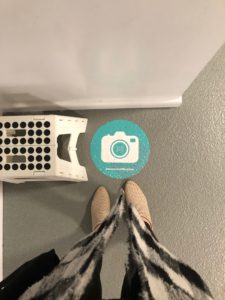 While walking around the exhibition I noticed the following image at each stop posted on the floor. A graphic of a camera encouraging the patron to stand in that precise spot to take a photo, suggestively for Instagram, Twitter, or some other form of social media as the graphic was followed by “#museumofillusions”. This idea of “Insta-worthy” museum spaces is what makes Pop Up Museums a competitor to traditional museums and cultural institutions.
While walking around the exhibition I noticed the following image at each stop posted on the floor. A graphic of a camera encouraging the patron to stand in that precise spot to take a photo, suggestively for Instagram, Twitter, or some other form of social media as the graphic was followed by “#museumofillusions”. This idea of “Insta-worthy” museum spaces is what makes Pop Up Museums a competitor to traditional museums and cultural institutions. 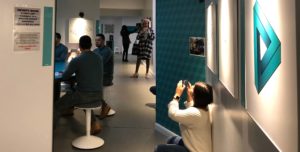
During my visit every patron had their phone out to take pictures, which is not odd behavior in a museum per say, but I was surprised by how much phones were being used. It felt as if I did not have my cell phone I would be missing out on part of the experience. This makes me wonder if there is a shift away from museum objects and their collections, or their information value, towards their entertainment value. Are pop-up museums perhaps an over-correction of traditional museums historical difficulty of engaging with their audiences? Especially in thinking about younger generations who may not be as interested in visiting a history or art museum, the Museum of Illusions is approachable and fun. I saw a lot of families with children ranging from toddlers, to teenagers, to grandparents running around the exhibition, taking pictures, and playing with the installations.
2. Multi-User Interactive Activities
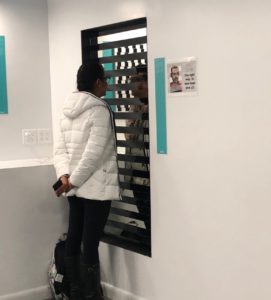 As I mentioned I wish I would have attended the exhibition with a friend. As most of the pieces were intended for use by two or more people! The interactive component of the museum not only makes it more fun for patrons, but also speaks to the intentions of curators or exhibition designers. In our readings about user-centered research, focus has either been placed on the user as an individual or on the community. I would love to learn more about the relationships between users in an information environment. Seeing families and friends interact with one another at the museum was one of my biggest takeaways. One of the more simple illusions was a kaleidoscope with openings at both ends for people to look at one another through. I imagine the effect was much cooler when doing this activity with another person, as when I did it on my own the kaleidoscope did not produce the same effect. The most popular piece on view combines my early point about Instagram potential with social elements. Upstairs there is a room with furniture set up on its side, when people stand in this room they can take photos that create the illusion they are suspended.
As I mentioned I wish I would have attended the exhibition with a friend. As most of the pieces were intended for use by two or more people! The interactive component of the museum not only makes it more fun for patrons, but also speaks to the intentions of curators or exhibition designers. In our readings about user-centered research, focus has either been placed on the user as an individual or on the community. I would love to learn more about the relationships between users in an information environment. Seeing families and friends interact with one another at the museum was one of my biggest takeaways. One of the more simple illusions was a kaleidoscope with openings at both ends for people to look at one another through. I imagine the effect was much cooler when doing this activity with another person, as when I did it on my own the kaleidoscope did not produce the same effect. The most popular piece on view combines my early point about Instagram potential with social elements. Upstairs there is a room with furniture set up on its side, when people stand in this room they can take photos that create the illusion they are suspended.
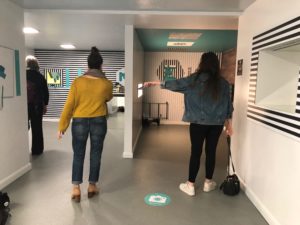
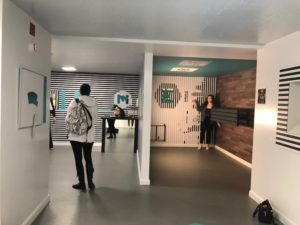
I observed a family who spent about fifteen minutes planning how they were going to stage this photo. What I witnessed was more than the typical Instagram posing, instead the daughters were problem solving with their parents, engaging with the illusion part of the piece by trying to figure out how to take the photo. My observations of the relationships and interactions I saw at the Museum of Illusions makes me consider the importance of social interaction in information environments, and how this may be one of the reasons for Pop Up Museums popularity and success.
3. Size of Exhibition + Cost
My two biggest criticisms of the Museum of Illusion would be size and cost. A student ticket was $18 and family tickets are $53. I understand why museums charge admission fees, but am baffled as to why the Museum of Illusions cost so much. The exhibition itself has no more 20 pieces. It took me about 45 minutes to go through the museum and I spent the rest of my time watching patrons interact with the exhibition. This made me think about incentive and how museums can successfully entice users into visiting their spaces. As someone who worked in visitor services at an art museum I have overheard a lot of griping and complaining about whether or not museums are worth their admission fee, but surprisingly enough the patrons at the Museum of Illusions seemed to be happy costumers. The museum seemed to know its market very well, and shaped the exhibitions to the wants and needs of the people.
All in all my observation of the Museum of Illusions as an information environment was eye opening. As a critic of the Pop Up Museum phenomenon, I was wary of what these temporary exhibitions with seemingly arbitrary themes had to offer patrons. Yet in thinking about my observation in conversation with Sanna Talja and Jenna Hartel’s arguements in their essay Revisting the user-centred turn in information science research: an intellectual history perspective, Pop Up Museums appear to be a natural progression in the over arching trend of information studies and user interaction. Talja and Hartel argue:
“The conceptualization of ‘users’ in the dual role of producer and consumer of information yields a broad and active role to the user. Garvey and Gottfredson (1979: 320) not only assumed that users should be placed at the center of systems designed and planned by someone else, they stressed that innovations and interventions in communication systems must ultimately be designed in collaboration with, or within, scholarly communities themselves or they will not become efficient and effective” (Talja Hartel 6).
Although the systems referred to in this passage are academic, the framework presented can be useful in helping us understand the success and overall importance of Pop Up Museums as information environments in the digital age. The Museum of Illusions is a direct response to the entertainment needs of its patrons, an observation that’s visible in the way the exhibition is constructed. The entertainment value of the space seems to take precedent over the content, but does not inhibit the exhibition’s success. The museum’s focus on fun as opposed to prestige or namesake makes this information environment approachable and in turn, accessible.
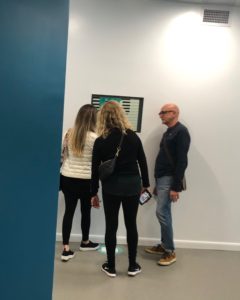
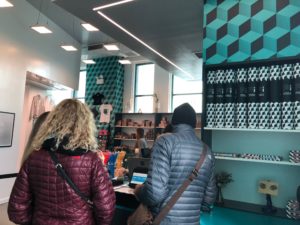
Works Cited:
- Hartel, Jenna & Talja, Sanna. (2007). Revisting the user-centred turn in information science research: an intellectual history perspective
- ICOM. (2017). ICOM Definition of a Museum. http://archives.icom.museum/definition.html
- Museum of Illusions New York. About Us. https://newyork.museumofillusions.us/about-us/
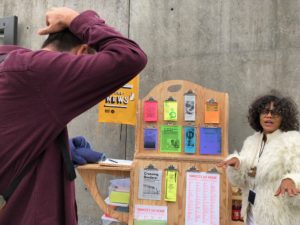
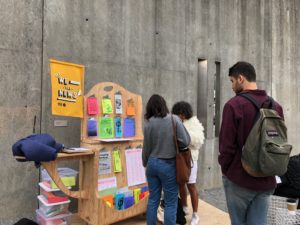
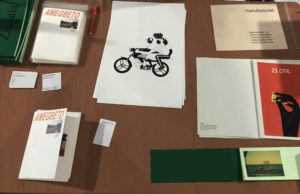
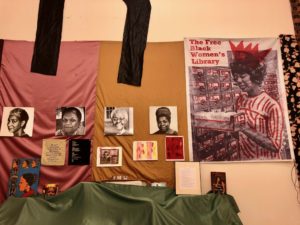
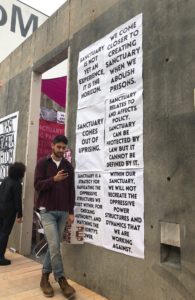
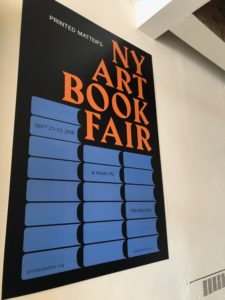 References
References